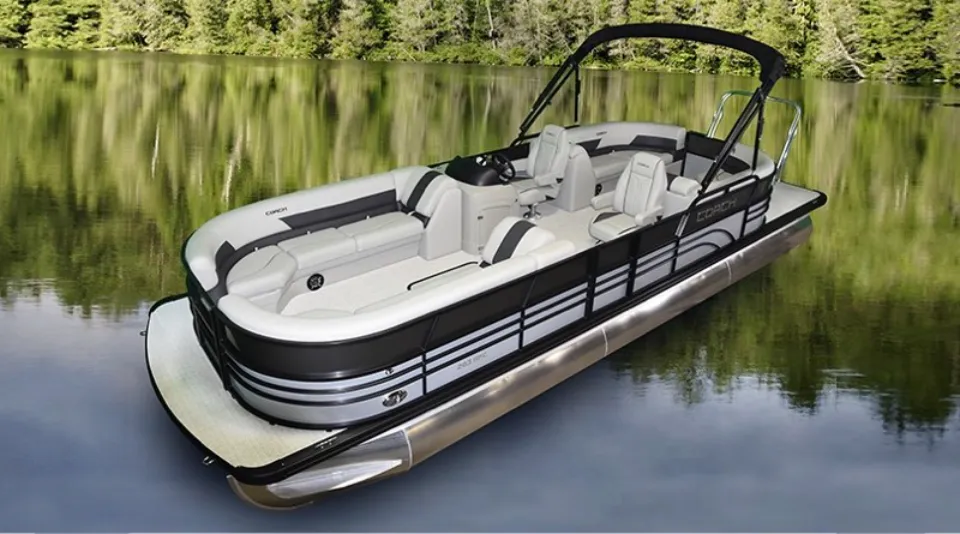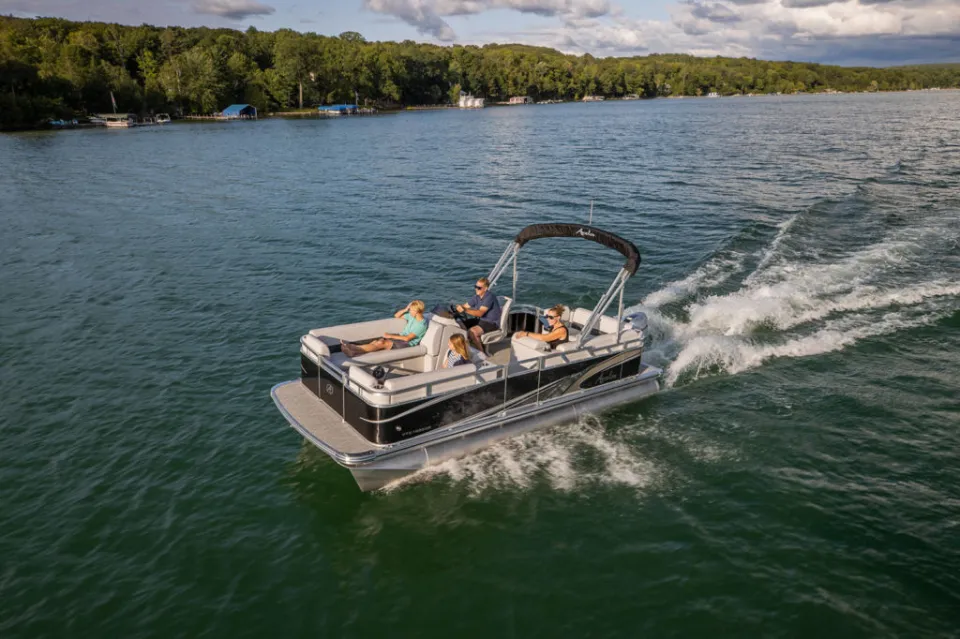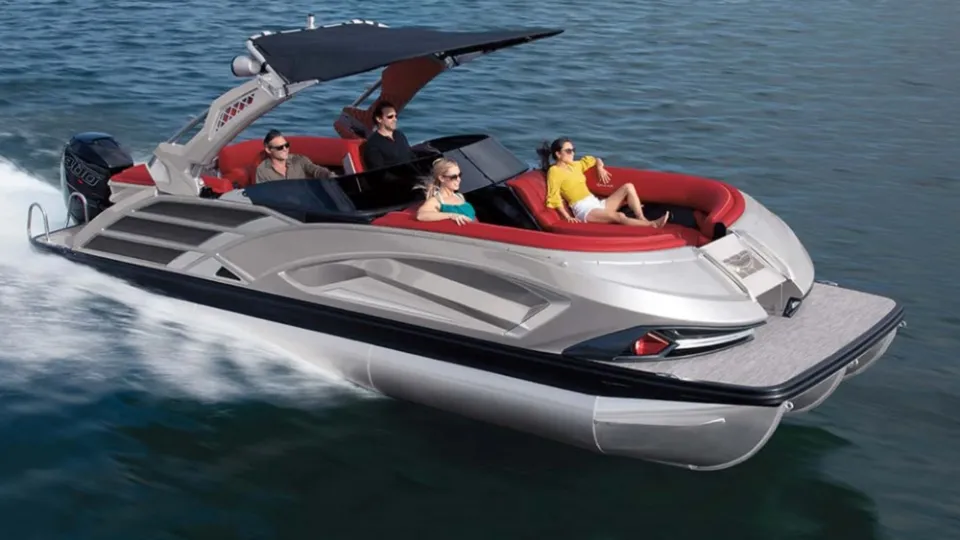The pontoon is easy to use once you’re cruising. To accelerate, decelerate, turn the boat around, and stop it, practice using the throttle.
If you’re new to boating, you may be trying to learn everything you can before getting on the water. I’m assuming that’s what led you to this blog, and I applaud you for wanting to learn everything you can in order to operate a boat safely.
With an outboard motor, operating a pontoon boat is as simple as it gets. So that you are fully prepared for when you take control of your pontoon boat, I will walk you through the entire procedure.
What is a Pontoon Boat?

Having two or three aluminum tubes (pontoons) on either side of the deck, a pontoon boat is a flat-decked vessel. The pontoons run the entire length of the craft and offer enough buoyancy for the decking (boat) to remain afloat. The pontoon tubes carry the deck above them, cutting through the water unlike V-shaped hulls.
A pontoon boat’s design allows for a variety of seating arrangements, including seats facing one another or placed around the decking’s edge. Between the two pontoon tubes in the middle back of the deck, an outboard motor is typically used to power pontoons.
It’s critical to keep in mind that a pontoon is a flat-decked boat that is intended to be cruised, not raced. Despite the fact that some manufacturers are giving some pontoons bigger motors, which makes them move faster, the boat’s design was not made for this.
How to Drive a Pontoon Boat
A pontoon boat is one of the easier boats to learn to drive because it moves through the water more slowly and sits higher than many other boats, giving the driver a better line of sight. You are now prepared to learn how to operate a pontoon, provided that you have already brought a fully charged cellphone, a working radio, checked your fuel tank, and used other safety equipment.
Make Sure Everyone is Wearing a Life Jacket
Anytime a boat is in the water and passengers are on board, they should always wear a life jackets. Making sure that everyone on your boat adheres to safety procedures is one of your duties as the operator. (Before I move the boat anywhere, I have no problem shame-tripping people into putting them on.
Turn the Ignition to the on Position
Depending on whether your pontoon boat has a push-button ignition, a dial ignition, or a key, you must decide how to start it. The electrical system will start working after you complete the task (push the button or turn the key). For the motor to warm up, the majority of manufacturers advise letting it idling for a few minutes.
Trim the Motor Down to the Water
The trim motor button is typically located next to the gearshift on pontoon boats. Set the motor just above the water by lowering it to the bottom and fully submerging the propeller. (If you are in shallow water, don’t fully trim the motor down. This action will allow you to control the pontoon’s movement in response to the commands you are about to give it.
Take a Good Look at Your Surroundings.
Make a plan for movement and pay attention to your surroundings. Always check to make sure there are no obstacles in the way of the boat if you need to reverse out of a slip or into deeper water. Making sure that everyone is seated evenly on both sides of the pontoon will help to balance the weight. Create a mental plan for maneuvering.
Remove the Ties to the Dock
Ropes that must be loosened secure the pontoon to the dock. A friend can do the work here, allowing you to remain in the command chair. You can continue to steer the ship even if something unfortunate occurs.
Throttle into Reverse Gently
After the last rope has been untied and secured correctly, gently move the throttle into Reverse. Avoid accelerating too quickly to avoid rubbing the boat’s side. The best speed to get past an obstacle like a dock or slip is slow. (Always check that the immediate area is free of swimmers and other objects.
Turn the Steering Wheel as Needed
Similar to the way the steering wheel in your car operates, a pontoon’s does too. Just turn the steering wheel gently to navigate away from the pier.
Trim the Motor Downward, If Needed
If you need to trim the motor down more, do so. The majority of handles have a trim button. Lower the number, and the motor will be submerged farther.
Push the Throttle Forward for Cruising Speed
Gently push the throttle forward to reach cruising speed once the pontoon is pointed in the direction you wish to go. Make sure to abide by all rules and regulations as many reservoirs and coastal bays have established speed limits and traffic lanes.
Keep Your Hands on the Steering Wheel.
Keeping one’s hands on the steering wheel is obvious advice for drivers. Avoid being distracted by any other riders so that you can operate the pontoon safely. Just as you wouldn’t let go of your car’s steering wheel, keep your hands on the wheel and close to the throttle.
Be Aware of Your Surroundings
You want to maintain a distance of at least 100 feet between you and any other vessels on the water. Use side-view and rearview mirrors to keep you mindful of any issues. (I always ask someone to act as a second set of eyes to spot any potential problems that I might have missed. It never hurts to have help when on the water).

Other Intangibles
One thing that you’ll always have to be mindful of is the wind. Windy days could be problematic because pontoons are mostly above the water. You should always know the weather conditions before you leave the dock for the day. If it’s going to be windy, consider staying near the shore where it’s not as rough. If you do catch yourself in rough waters, there are a few tips to follow:
- Don’t turn into the wind. Try to turn with it instead.
- To help you better handle the waves, make sure weight is distributed evenly throughout the pontoon.
- Try to stay above the waves.
- If you feel uncomfortable, head back to the dock or to calmer water.
Two-Hull Vs. Three-Hull Pontoon Boats
Two equal-sized hulls mounted separately on either side of the main structure make up the majority of pontoon boats’ two-hull construction. Others, however, are constructed with three hulls, one larger in the center and two smaller ones on either side. Each design has advantages and disadvantages, and they all operate somewhat differently.
Two-hull pontoons sit level in the water, with the weight distributed evenly across both sides. The outer hull of the boat tips outwards when it corners because of the increased weight on it. A single-hull boat would typically bite into a turn, but this is the opposite effect.
As a result, two-hull pontoons corner with a long turn radius. They are unsuitable for making tight, 90-degree turns and less stable than three-hull pontoon boats (albeit still more stable than single-hull boats).
Due to their larger center hull, three-hull pontoons are made to corner more effectively. It combines the best aspects of both worlds. Three-hulls can bite into turns, with the center pontoon cutting into water, while the outside pontoon lifts into the air. With this design, stability is improved and cornering is improved.
In Closing
If you’re buying a pontoon boat for the first time, make sure you’re familiar with the laws in your state and your neighborhood. When it’s all said and done, boating is about common sense. When you’re out on the water, always follow your gut and pay attention to your surroundings. Before you set out on your journey, make sure to choose your destination, keep an eye out for other boats and buoys, and keep up with the weather.
FAQs
Is a Pontoon Boat Easy to Drive?
The reason pontoon boats are so common is that they are comparatively simple to operate. For people learning to operate a boat, they make good learning vessels. They sit relatively high off the water for their size, which helps them handle well at lower speeds and gives the driver a good vantage point and view of the water.
Are Pontoons Good for Beginners?
Pontoons are ideal for beginning boaters and provide more space for families. They’re easy to drive and simple to dock because of the shape and speed of the boat. Since they are hard to tip or flip due to their size, pontoon boats are also safe.
How Do You Stop a Pontoon Boat?
You can move forward by applying forward throttle, which will act as drive. The more you advance the throttle, the faster it will move. If you pull the throttle backwards into reverse, that’s the “brakes”, that’s how you stop a forward moving boat as I mentioned above.

